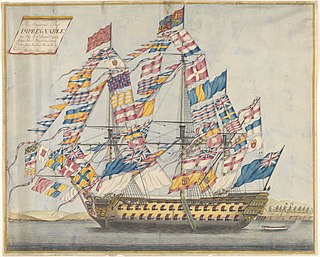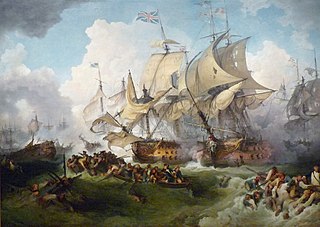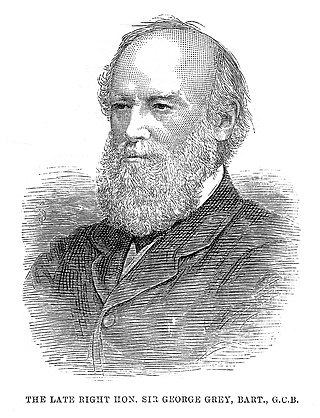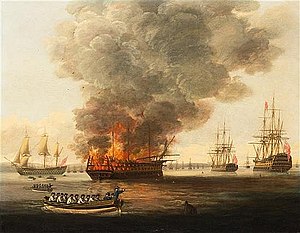HMS Sceptre was a 64-gun third-rate ship of the line of the Royal Navy, launched on 8 June 1781 at Rotherhithe. The ship was wrecked in a hurricane on 5 November 1799 in Table Bay near the Cape of Good Hope.
Six ships of the British Royal Navy have been named HMS Boyne after the Battle of the Boyne, 1690.

HMS Captain was a 74-gun third-rate ship of the line of the Royal Navy, launched on 26 November 1787 at Limehouse. She served during the French revolutionary and Napoleonic Wars before being placed in harbour service in 1799. An accident caused her to burn and founder in 1813. Later that year she was raised and broken up.

HMS Hannibal was a 74-gun third-rate ship of the line of the Royal Navy, launched on 15 April 1786, named after the Carthaginian general Hannibal. She is best known for having taken part in the Algeciras Campaign, and for having run aground during the First Battle of Algeciras on 5 July 1801, which resulted in her capture. She then served in the French Navy until she was broken up in 1824.

HMS Caledonia was a 120-gun first-rate ship of the line of the Royal Navy, launched on 25 June 1808 at Plymouth. She was Admiral Pellew's flagship in the Mediterranean.

HMS Zebra was a 16-gun Zebra-class sloop of the Royal Navy, launched on 31 August 1780 at Gravesend. She was the second ship to bear the name. After twenty years of service, including involvement in the West Indies campaigns during the French Revolutionary Wars, she was converted into a bomb vessel in 1798. In this capacity she took part in attacks on French ports, and was present at both battles of Copenhagen. The Navy sold her in 1812.

HMS Impregnable was a Royal Navy 98-gun second rate ship of the line launched on 15 April 1786 at Deptford Dockyard. She was wrecked in 1799 off Spithead.

HMS Cambridge was an 80-gun third-rate ship of the line of the Royal Navy, designed by Sir Joseph Allin and built at Deptford Dockyard by Adam Hayes to the draught specified by the 1745 Establishment as amended in 1750, and launched on 21 October 1755.

Robert Faulknor the younger (1763–1795) was an 18th-century Royal Navy officer, part of the Faulknor naval dynasty. He was court-martialled and died in an action off Guadeloupe in the eastern Caribbean Sea.
HMS Bedford was a Royal Navy 74-gun third rate. This ship of the line was launched on 27 October 1775 at Woolwich.
HMS Ardent was a Royal Navy 64-gun third rate. This ship of the line was launched on 21 December 1782 at Bursledon, Hampshire. She disappeared in 1794, believed lost to a fire and explosion.

HMS Queen Charlotte was a 100-gun first-rate ship of the line of the Royal Navy, launched on 15 April 1790 at Chatham. She was built to the draught of Royal George designed by Sir Edward Hunt, though with a modified armament.

HMS Cressy was a 74-gun third rate ship of the line of the Royal Navy, launched on 7 March 1810 at Frindsbury.

HMS Hindostan was a 56-gun fourth-rate ship of the line of the Royal Navy. She was originally the East Indiaman Hindostan, launched in 1789, that the Admiralty bought in 1795. She is known for two events, her voyage to China between 1792 and 1794 when she carried Lord Macartney on a special embassy to China, and her loss in a fire at sea in 1804.

HMS Terpsichore was a 32-gun Amazon-class fifth-rate frigate of the Royal Navy. She was built during the last years of the American War of Independence, but did not see action until the French Revolutionary Wars. She served during the French Revolutionary and Napoleonic Wars, in a career that spanned forty-five years.

Sir George Grey, 1st Baronet, was a British Royal Navy officer and a scion of the noble House of Grey who served as Master and Commander of the Mediterranean Fleet. He joined the Royal Navy at the age of 14 and was on active service from 1781 to 1804, serving in the American War of Independence, the French Revolutionary War and the Napoleonic War. He served as Flag Captain for John Jervis, Earl of St Vincent and later as Flag Captain for King George III on his royal yacht. From 1804 to 1806, he was Commissioner at Sheerness Dockyard, and from 1806 until his death in 1828 he was Commissioner at Portsmouth Dockyard.
HMS Venom was a captured in the Caribbean in 1794 that Admiral Sir John Jervis purchased. The Royal Navy commissioned her as a gunbrig under the command of Lieutenant Thomas H. Wilson. In March and April 1794, she participated in the capture of Martinique, St. Lucia, and Guadeloupe. Jervis's expedition restored monarchist rule. The French counter-attacked and recaptured Guadeloupe on 2 June. Jervis and General Sir Charles Grey, the army commander, landed a force to recapture the island but the reinforced French garrison repulsed the British expedition, which withdrew.

HMS Woolwich was an Adventure-class frigate launched in 1784. She essentially spent her career as a storeship until she was wrecked in 1813.
Rear-Admiral Sir John Ferris Devonshire (1774–1839) was an officer in the Royal Navy. He joined as a volunteer aboard HMS Cumberland in 1788 and served in various vessels in the waters around North America and the West Indies until 1795 when he moved to HMS Boyne, the flagship of John Jervis. Devonshire was acting lieutenant for a while before Jervis promoted him to full lieutenant aboard HMS Terpsichore, at that time employed in the defence of a British garrison under siege on Basse-Terre.
Samuel Campbell Rowley was a politician and Royal Navy officer who was born in Ireland in 1774. Rowley attended the Royal Naval Academy at Portsmouth in 1785 and joined his first ship in March 1789, serving in the West Indies. He passed the lieutenant's examination in 1792 but was not promoted until January 1794, when he joined HMS Vengeance. In her, Rowley took part in the West Indies campaign under Sir John Jervis and Sir Charles Grey, and was present at the capture of Martinique, St Lucia and Guadeloupe. Rowley returned to England at the beginning of 1795 and shortly after, was appointed to the 32-gun HMS Astraea, serving in the English Channel, where, on 10 April 1795, he assisted in the taking of the French 42-gun frigate, Gloire.















